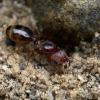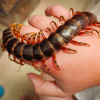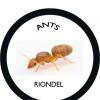Hello everyone!
I'm back again, this time with regards to my personal favorite (Native) species: Pheidole pilifera! Over my years spent obsessing over them, I've managed to compile a rather impressive amount of information, which is awesome considering not a ton is known about them. In this post I'll be discussing their flight behaviors in particular. Enjoy! And please, correct me on anything you find to be inaccurate.
Just as a disclaimer, this information is relevant to populations in the north. I am from Massachusetts, and all of my personal experience comes from colonies in Massachusetts. From what I know, the information below is still very similar for all areas of their northern distribution, Midwest, northeast, and any Canadian populations. The south may vary slightly, due to their environmental and climatic differences.
To start off, let's go over the basics. Ph. pilifera fly from late June to early August, although in the north they can go well into August if conditions persist to be unfavorable. As for time of day, 12:00 pm to dusk. Although, very, very rarely they have been observed to show up at blacklights past dusk. In my opinion, I wouldn't consider blacklighting for P. pilifera to be a very good method for this Pheidole species in particular, unless you are blacklighting in an area with a healthy, established population, and directly after flight conditions have been met.
VERY IMPORTANT: To clarify, you cannot simply just go for a stroll around your neighborhood after flight conditions have been met, and just hope you'll find pilifera, as you might with other species. Ph. pilifera have very specific nesting requirements and aren't widespread like other species, but are rather locally abundant. This means that you need to find a population, and go there during flights in order to find queens.
Now, if you are familiar with P. pilifera, you've probably heard that they fly "after rain", which is partly true, but also very misleading. In the years where I've tracked flights, and from what others have observed, they seem to trigger flights more readily under certain types of storms, not just "rain" in general. Short, heavy, passing storms in particular. Thunderstorms seem to be slightly favored, but not essential. 5-30 minute storms are what trigger the largest flights but longer storms still may provoke smaller flights/nuptial swarming. Storms that last overnight and into the next day to not trigger flights.
Using a weather app to track storms is a very important tool you need to use. Personally, I use the weather app, but any reliable website/app with a radar will work just fine. Generally, for the duration of their flights, I just checked the radar for the day when I got up (as long as you get up before noon ![]() ). It's important to check the radar as frequently as possible when tracking a storm, seeing as the weather we are looking for (in terms of provoking pilifera to fly) is often very unpredictable and usually changes quite a bit throughout the storms as it moves. What you're looking for on the radar is a storm that basically looks like a line, with heavy precipitation in the middle. Knowing exactly when the rain is starting and stopping is essential given how small their flight window is. Being an hour too late may mean you miss their flights entirely. My point is, you need timing down to the minute with pilifera, especially if you are biking/walking to your population and need to leave early in order to arrive on time. If you are biking/walking, bringing a rain coat and simply traversing through the rain is the best method. If you have a car, you can just drive down, wait out the rain inside of your vehicle, and then begin looking as soon as the rain stops.
). It's important to check the radar as frequently as possible when tracking a storm, seeing as the weather we are looking for (in terms of provoking pilifera to fly) is often very unpredictable and usually changes quite a bit throughout the storms as it moves. What you're looking for on the radar is a storm that basically looks like a line, with heavy precipitation in the middle. Knowing exactly when the rain is starting and stopping is essential given how small their flight window is. Being an hour too late may mean you miss their flights entirely. My point is, you need timing down to the minute with pilifera, especially if you are biking/walking to your population and need to leave early in order to arrive on time. If you are biking/walking, bringing a rain coat and simply traversing through the rain is the best method. If you have a car, you can just drive down, wait out the rain inside of your vehicle, and then begin looking as soon as the rain stops.
Now, if you are late to a flight for whatever reason, don't worry to much because you still have an opportunity to find queens. Ph. pilifera dig insanely deep nests, in a young colony of ~150 individuals, the deepest chamber was 35 inches below the surface. In mature colonies, I would not be surprised if this number approached double that. That being said, this behavior seems to be no different within the queens, which tend to dig very deep claustral cells of 8-14 inches. Seeing as they dig extremely deep, it takes them a considerable amount of time before they are underground and sealed off. Meaning, the more time they are actively popping in and out to dig - the more time you can see them and collect them. I found a queen about an hour and a half after rain because I spotted a claustral cell mound. They make little crescent shaped mounds, about a nickel in size.
That's pretty much it! As a recap, they can fly as early as the last week of June, or as late as August immediately following short and heavy Afternoon rainstorms. Using a radar to track storms is essential to plan ahead and predict their flights.
Thank you for reading, and feel free to ask me any questions you may have. Additionally, I want to mention that if you do come across flights or a colony of pilifera, be sure to record it on iNaturalist.
Edited by Antkeeper014, July 7 2022 - 2:56 PM.





















